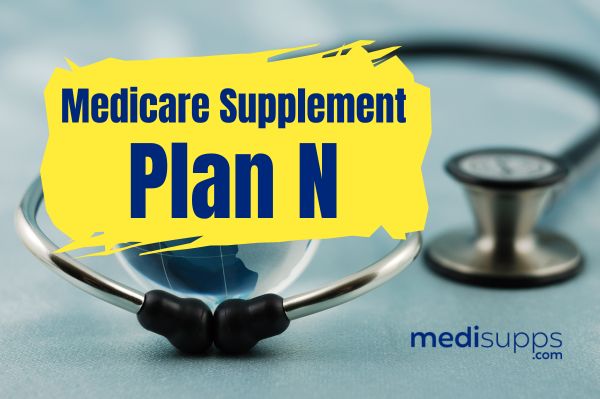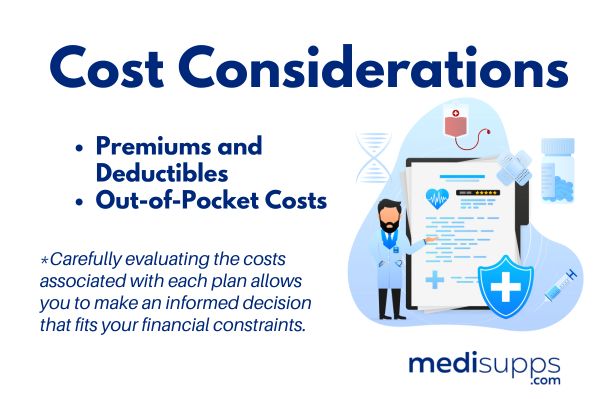
by Russell Noga | Updated July 11th, 2025
Searching for Medicare Supplement Plans Oklahoma 2026? This guide details the best plans like Plan G, Plan N, and Plan F, upcoming regulatory changes, and essential enrollment tips. Stay informed to choose the right plan for your needs and budget.
Key Takeaways
- Medicare Supplement Plans (Medigap) cover out-of-pocket costs not paid by Original Medicare, providing financial security and nationwide access to care.
- Top plans in Oklahoma for 2026 include Plan G, Plan N, and Plan F, each offering different benefits and cost structures to cater to varying healthcare needs.
- Eligibility for Medigap plans begins upon enrolling in Medicare Part A and B, with the best time to enroll during the six-month Medigap Open Enrollment Period to avoid medical underwriting.
Compare 2026 Plans & Rates
Enter Zip Code
Overview of Medicare Supplement Plans (Medigap)

Medicare Supplement Plans, commonly referred to as Medigap, are designed to fill the financial gaps left by Original Medicare. These plans are offered by private insurers and help cover out-of-pocket costs such as copayments, deductibles, and coinsurance that are not fully paid by Original Medicare. Medigap plans provide a safety net for Medicare beneficiaries, ensuring that healthcare costs remain manageable and predictable.
For those who rely on Medicare, understanding Medigap is crucial for addressing their healthcare needs. Unlike Medicare Advantage Plans, which are an alternative to Original Medicare, Medigap plans work alongside Original Medicare to enhance coverage. This symbiotic relationship ensures that beneficiaries can access a broader range of services without the worry of unexpected medical expenses.
This section explores what Medicare Supplement Plans are, their benefits, and the eligibility criteria for enrollment.
What Are Medicare Supplement Plans?
Medicare Supplement Plans, or Medigap, are specifically designed to cover the costs that Original Medicare does not pay in full. These costs typically include deductibles, copayments, and coinsurance, which can add up quickly, especially for those with ongoing medical needs. Covering these out-of-pocket expenses, Medigap plans create a financial buffer, aiding Medicare beneficiaries in managing their healthcare budgets more effectively.
While Original Medicare covers many essential services, it usually does not pay for additional benefits such as dental and vision care. However, some Medigap policies offer the option to include these types of coverage, providing a more comprehensive healthcare package. The added flexibility of Medigap plans makes them an attractive option for enhancing overall health benefits.
Benefits of Medicare Supplement Plans

One of the primary benefits of Medigap plans is their ability to fill the financial gaps left by Original Medicare. Covering costs like deductibles, copayments, and coinsurance, these plans offer predictable out-of-pocket expenses, aiding beneficiaries in managing their healthcare costs more effectively. This predictability provides peace of mind, allowing individuals to focus on their health rather than worrying about unexpected medical bills.
Medigap plans also offer nationwide coverage, adding to their financial security benefits. This means that beneficiaries can receive care from any provider that accepts Medicare, without being restricted to a specific network. This coverage is especially beneficial for frequent travelers or those with multiple residences.
Another significant advantage of enrolling in a Medigap plan is the reduction in overall out-of-pocket costs. By covering a significant portion of medical expenses not included in Original Medicare, Medigap plans ensure that beneficiaries can access the medical care they need without the burden of high medical bills.
Eligibility and Enrollment
To be eligible for a Medigap plan, individuals must be enrolled in Medicare Part A and Part B. Typically, eligibility begins when an individual turns 65 and enrolls in Medicare, but there are specific enrollment periods that are crucial to consider. The optimal time to enroll in a Medigap plan is during the six-month period following enrollment in Medicare Part B, known as the Medigap Open Enrollment Period.
This period grants individuals guaranteed issue rights, allowing them to purchase any available Medigap plan without medical underwriting. This ensures that beneficiaries can obtain coverage regardless of their health status. However, waiting until after this period can result in higher premiums and potential denials based on pre-existing conditions.
Top Medicare Supplement Plans Available in Oklahoma for 2026
Looking ahead to 2026, Plan G, Plan N, and Plan F remain the most popular Medicare Supplement Plans in Oklahoma. Each of these plans offers a unique set of benefits, catering to different needs and budgets. Understanding the specifics of each plan can help you make an informed decision about which coverage is right for you.
This section details the top Medigap plans, covering their options, cost-sharing features, and eligibility requirements.
Plan G

Plan G is one of the most comprehensive Medigap plans available, covering a wide range of out-of-pocket costs not paid by Medicare, such as deductibles, copayments, and coinsurance. This extensive coverage makes Plan G a popular choice among new enrollees who seek robust protection against healthcare expenses.
The primary difference between Plan G and other plans is that it does not cover the Medicare Part B deductible. However, its comprehensive benefits make it a reliable option for those who want to minimize their out-of-pocket healthcare costs.
Plan N

Plan N offers a balance between comprehensive coverage and cost savings. It covers many out-of-pocket expenses for Medicare recipients, including Medicare Part A and Part B coinsurance. However, it features lower premiums compared to Plan G, making it an attractive option for those looking to save on monthly costs.
One key aspect of Plan N is its cost-sharing structure. While it has lower premiums, beneficiaries may be required to pay copayments for certain services, such as doctor visits and emergency room visits. This trade-off makes Plan N a budget-friendly option for those who do not frequently use medical services.
Plan F

Plan F is known for its extensive coverage, making it the most comprehensive Medigap plan available. It covers all deductibles and copayments, providing maximum financial protection for Medicare beneficiaries. However, it’s important to note that Plan F is only available to individuals who were eligible for Medicare before January 1, 2020.
For those who qualify, Plan F offers unparalleled coverage, ensuring that nearly all out-of-pocket expenses are covered. This plan is particularly beneficial for individuals with significant healthcare needs who want to avoid unexpected medical bills.
Compare Medicare Plans & Rates in Your Area
Comparing Costs of Medicare Supplement Plans in Oklahoma

The cost of Medicare Supplement Plans in Oklahoma can vary significantly based on the plan chosen and the provider. Factors such as age, location, and health status can all influence the premiums and out-of-pocket expenses associated with these plans. Grasping these cost variations is crucial for making an informed plan choice.
This section examines factors affecting Medigap plan costs, including premium variations, out-of-pocket expenses, and other influences.
Premium Variations
Premiums for Medicare Supplement plans can vary widely based on several factors, including the age of the policyholder and their geographic location. Premiums, for instance, may be higher for older individuals or residents in high healthcare cost areas. Additionally, the specific plan chosen can also impact the cost, with more comprehensive plans typically having higher premiums.
Plan N, for instance, offers lower premiums compared to Plan G, but includes cost-sharing features such as copayments for certain services. This makes Plan N a more budget-friendly option for those who prefer lower monthly costs and are willing to pay some out-of-pocket expenses.
Out-of-Pocket Expenses
Out-of-pocket expenses are another crucial factor to consider when comparing Medigap plans. Plan G, for example, covers nearly all out-of-pocket costs except for the Medicare Part B deductible, making it a favored choice for many new enrollees. This comprehensive coverage ensures that beneficiaries have minimal additional costs when accessing healthcare services.
Conversely, Plan N has lower premiums but requires copayments for doctor visits and emergency room services. This cost-sharing structure can lead to reduced overall costs for those who do not frequently utilize medical services, making it a cost-effective choice for many.
Factors Affecting Costs
Several factors can influence the cost of Medicare Supplement Plans, including an individual’s health status and the timing of enrollment. For instance, enrolling during the Medigap Open Enrollment Period guarantees the best rates, while waiting until after this period can result in higher premiums and potential denials based on pre-existing conditions.
Health status at the time of applying for Medigap coverage can also affect the cost. Individuals with pre-existing health conditions may face higher premiums, reflecting the anticipated costs for potential health services. Considering these factors ensures that the selected Medigap plan aligns with both health needs and financial capabilities.
How to Choose the Right Medicare Supplement Plan

Choosing the right Medicare Supplement Plan involves evaluating various factors, including individual health needs, financial circumstances, and available plan options. Each person’s situation is unique, and selecting the best plan requires careful consideration of these elements.
This section guides you through assessing health needs, considering your budget, and consulting experts to find the most suitable Medigap plan.
Assessing Your Health Needs
Understanding your personal medical history and current health conditions is crucial when selecting a Medicare Supplement Plan. Evaluating current health issues and future needs aids in choosing a plan that provides necessary coverage without unnecessary costs. Additionally, considering potential future healthcare needs alongside current health conditions is essential in making an informed decision.
Health status at the time of applying for Medigap coverage can also impact the cost, as insurers may consider pre-existing conditions. Therefore, it’s important to forecast potential future healthcare needs to select a plan that offers the best value and coverage.
Budget Considerations
Balancing premium costs with potential out-of-pocket expenses is crucial for finding a fitting Medicare Supplement Plan. Evaluating the overall cost, including premiums, deductibles, and potential out-of-pocket expenses, can significantly impact the affordability of a plan.
Careful consideration of all costs is required to find an affordable Medigap plan. Balancing monthly premium costs with potential out-of-pocket expenses ensures that you choose a plan that aligns with your financial situation while providing the necessary coverage.
Changes to Medicare Supplement Plans in 2026

Approaching 2026, several changes to Medicare Supplement Plans are anticipated. Grasping these changes is crucial for current enrollees and those considering Medigap plans. These adjustments could impact coverage options, costs, and eligibility criteria, making it essential to stay informed.
This section discusses new regulations, their impact on current enrollees, and future Medigap market trends.
New Regulations
The Centers for Medicare & Medicaid Services (CMS) has proposed several new regulations that could affect Medigap plans starting in 2026. For instance, future enrollment in Medicare Advantage may limit guaranteed issue rights for Medicare Supplement plans, which means beneficiaries might face more restrictions when switching between plans. Additionally, new cost-sharing limits for behavioral health services are expected to be implemented, impacting coverage options for these services.
Other notable changes include measures to ensure that the use of artificial intelligence in healthcare does not lead to discrimination against patients. Transparency requirements for Medicare Advantage organizations regarding their internal coverage criteria will also be enhanced, helping beneficiaries make more informed decisions about their covered drugs and the proposed rule.
These changes aim to simplify enrollment and improve access to necessary medical services.
Impact on Current Enrollees
Current Medigap enrollees may need to reassess their coverage due to expected changes in 2026. These adjustments could affect their existing plans and require them to consider switching to a different Medigap plan that better suits their evolving healthcare needs and financial situations.
Future Trends
The Medicare Supplement market is expected to grow steadily due to the increasing aging population. Innovations in technology and healthcare delivery will likely shape the types of Medigap plans available in the future, offering more tailored and efficient healthcare solutions.
Moreover, consumers are becoming more discerning, favoring plans that offer better cost-sharing options and additional benefits. Younger Medicare beneficiaries, in particular, tend to prefer Medigap plans that include digital communication features and telehealth services.
Regulatory changes at both federal and state levels are anticipated to influence Medigap pricing and benefits in the coming years, making it essential for beneficiaries to stay informed and adaptable.
Additional Benefits and Services

In addition to standard coverage, some Medigap plans offer extra benefits such as vision, dental, and hearing services. These additional benefits can significantly enhance the overall healthcare package for Medicare beneficiaries, providing more comprehensive care beyond what Original Medicare offers.
This section explores additional benefits in Medigap plans, including vision and dental coverage, hearing aid coverage, and transportation assistance.
Vision and Dental Coverage
Some Medigap plans can be combined with separate vision and dental insurance to cover routine exams and services. This is particularly important for seniors, as maintaining good vision and dental health is crucial for overall well-being. These combined plans offer a more holistic approach to healthcare, addressing needs that are often overlooked by standard Medicare coverage.
Many seniors require additional vision and dental services to maintain their overall health and well-being. Including these benefits, Medigap plans offer more comprehensive coverage, ensuring access to necessary medical services without significant out-of-pocket expenses.
Hearing Aid Coverage
Hearing aids are essential for many seniors, yet most Medigap plans do not cover these devices. However, certain Medigap policies provide specific benefits for hearing aids, making it easier for beneficiaries to obtain the necessary support for hearing impairments. This inclusion can be a significant advantage for those who require hearing aids, reducing the overall cost burden.
Although standard Medicare excludes hearing aids, some Medigap plans include these benefits. This ensures beneficiaries have access to essential hearing services, improving their quality of life and overall health.
Transportation Assistance
Transportation assistance is a valuable benefit offered by some Medigap plans, particularly for seniors who may have difficulty reaching medical appointments or health services. Plans like Plan G and Plan N may include transportation assistance, facilitating easier access to healthcare.
Beneficiaries should check with their specific Medigap provider to understand how to utilize these services.
Steps to Enroll in a Medicare Supplement Plan in Oklahoma
Enrolling in a Medicare Supplement Plan in Oklahoma involves several steps, including determining eligibility, gathering required documentation, and completing the enrollment process. Understanding these steps is crucial for ensuring a smooth and successful enrollment experience.
This section provides a step-by-step guide on enrolling in a Medigap plan in Oklahoma City, covering the best times to enroll, necessary documentation, and final enrollment steps.
When to Enroll
The best time to enroll in a Medigap plan is during the Medigap Open Enrollment Period, which begins when you turn 65 and enroll in Medicare Part B. This six-month period guarantees that you can purchase any Medigap plan available in your area without being subject to medical underwriting, ensuring that you receive the best rates and coverage options.
Required Documentation
When enrolling in a Medigap plan, you will typically need to provide your Medicare card, personal identification, and possibly proof of prior health coverage. Having all necessary documentation ready can streamline the enrollment process and avoid delays.
Completing the Enrollment Process
To complete the enrollment process, you will need to fill out and submit the application form to your chosen insurance provider. After submission, you will receive an acknowledgment from the insurer confirming your application and providing further steps.
Keep an eye out for any additional communication from your insurer regarding the status of your application and any next steps you need to take.
Compare 2026 Plans & Rates
Enter Zip Code
Summary
In conclusion, understanding the nuances of Medicare Supplement Plans in Oklahoma for 2026 is crucial for making informed decisions about your healthcare coverage. From knowing the top plans available, such as Plan G, Plan N, and Plan F, to comparing costs and additional benefits, this guide has provided comprehensive insights to help you navigate the complexities of Medigap. By assessing your health needs, considering your budget, and consulting with experts, you can choose a plan that best suits your requirements. Stay informed about upcoming changes and take proactive steps to ensure you have the coverage you need for the future.
Frequently Asked Questions
What are Medicare Supplement Plans?
Medicare Supplement Plans, or Medigap, are private insurance plans designed to cover out-of-pocket costs not covered by Original Medicare, including copayments, deductibles, and coinsurance. These plans help enhance your Medicare coverage and reduce your overall healthcare expenses.
What is the best time to enroll in a Medigap plan?
The best time to enroll in a Medigap plan is during the Medigap Open Enrollment Period, which lasts for six months starting from the month you turn 65 and enroll in Medicare Part B. This ensures you can obtain coverage without medical underwriting.
How do Plan G and Plan N differ?
Plan G provides extensive coverage with the exception of the Part B deductible, while Plan N features lower premiums but involves copayments for specific services.
What potential additional benefits can Medigap plans offer?
Medigap plans can provide potential additional benefits such as vision, dental, and hearing services, enhancing your overall healthcare coverage. Consider these options to help address your broader health needs.
What changes to Medigap plans are expected in 2026?
The changes for the 2026 Medicare Supplement year have not been announced yet. Please refer back to this website for updated information.
Speak to the Professionals about Medigap Plans and Original Medicare
If you find understanding the benefits involved with Original Medicare and Medigap Plans challenging, you’re not alone. Whether it’s a Medigap plan, or you want to know more about the Medicare Supplement Plans Oklahoma 2026, we can help. Call our team at 1-888-891-0229 for a free consultation or complete the contact form on this site, and an expert will call you back at a convenient time.
We have decades of experience advising our clients on the complexities of Medicare and Medigap plans, the benefits, costs and deductibles. We’ll ensure you get the best rate in your state and advice you can trust.



